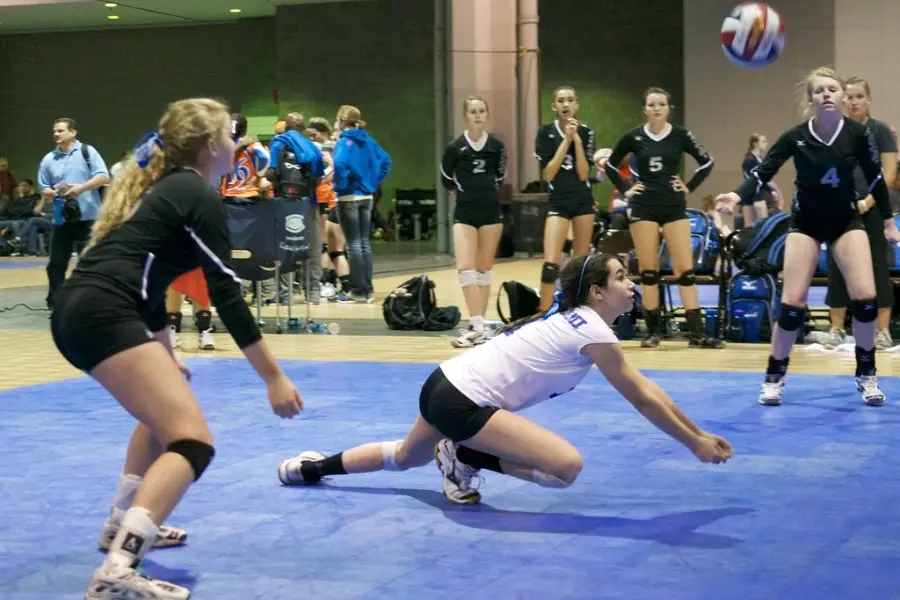In libero drills, passing the ball can only be done for so long. Digging drills are what separates great liberos from decent liberos, so spend most of your time practicing them.
Below I have compiled a list of my favorite Libero Volleyball Drills of all skill levels on Volleyballblaze that don’t require a lot of teammates to practice. The result is that they are ideal for two or three people doing them together.
Let’s get started!
Libero Drills & Workouts

Volleyball libero drills play a crucial role in a team’s success due to their defensive skills and reliable passing ability. It is important to enhance your defensive capabilities and agility as a libero if you want to excel. Physical fitness, footwork, reaction time, reading skills, communication abilities, and overall footwork can all be improved using the following drills.
Net Save Digging Drill
Liberos are responsible for covering your outside hitters, which means getting up close to the net in order to guard against blocks. This drill can prepare you for the scenario in which you will need to dig out a ball from the net every so often.
In order to practice saving more difficult balls, the thrower should toss the ball quite forcefully and quite far to the left and right of the digger instead of setting the ball.
You may enjoy reading Can You Wear Basketball Shoes For Volleyball?
Knee Digging Drill
You’re forced to choose between digging and setting the ball when someone beams volleyballs at you while you’re on your knees. You’ll likely end up getting a lot of balls here since you’re low to the ground, so it’s a good way to really strengthen your fingers.
Starting low on the ground in your typical ready position and quickly raising your hands to set a ball that’s heading for your head and shoulders is an important aspect of digging.
You can use this drill to practice changing styles quickly.
Single Arm Digging Drill
In the vast majority of cases, you can’t get your arms together to form a platform when digging a hard-driven ball. It’s really important to be able to dig the ball using just one forearm, and this is a skill you need to learn.
As you watch the above clip, you will notice how low the athlete is on the ground. One thing to keep in mind when doing this drill is to remain super low-ready.
Libero Diving Drill
Liberos are often in position 5 ready to defend spikes, only to have the hitter tip the ball at the last minute. In order to avoid hitting the ground with that tip, you must launch yourself forward.
My favorite drill for practicing this situation is this one. As you’re in the typical ready position, have your partner throw/drop balls in a random order so you have to dive to make your dig. Beginners are likely to struggle with this drill. Often, volleyball players who are less experienced won’t make a good dig because they are too worried about diving.
In this drill, the most important thing is to put the most important things first. Don’t even think about diving or landing awkwardly until you get under that ball and dig it as accurately as possible.
Watching Jenia Grebennikov (the no. 1 libero in the world), you’ll notice that he rarely dives, and when he does, it’s not the kind of smooth, elegant dolphin dive you’d expect. It is common for defenders to sacrifice their effectiveness for the sake of making a nice-looking dive.
That’s not how you should be.
Wall Digging Drill
Using just two people and a wall, you can do this super simple yet highly effective drill. Keeping a low and ready position is the objective here, as is reacting quickly to the ball when it comes.
Diggers have to be ready for anything since they won’t know exactly where the ball will go since the thrower is behind them. Starting low and staying low throughout the digging motion is crucial, as is avoiding popping up when contacted.
You can improve your reaction time by doing this drill. By throwing harder or farther from the center of the digger, the thrower can make this drill more difficult for the libero.
A turn-and-dig digging drill
In addition to having amazing reaction times, good liberos are passionate about saving every ball they face. When the hitter slaps the ball, turn quickly and jump/spin around to get into your position and ready to receive.
Depending on the hitter, the ball will either be spiked hard at you or tipped hard at you. Dig everything you can!
Just one player is needed for this drill, which is super duper simple. While remaining in a position where they can comfortably dig a hard-driven spike, the libero needs to pay close attention to the hitter’s arm swing and identify tips early.
You may enjoy reading Can You Wear Tennis Shoes For Volleyball?
Serving Machine Passing Drill
It is important to practice passing skills with a volleyball serving machine, especially for fairly high-level men’s volleyball where people are actually jumping serve quite a bit.
Drilling passing top spin serves this way is the most effective way to get tons of repetitions in. Practicing passing against float serves is probably more worthwhile if you’re playing women’s volleyball or at a lower level where there aren’t many jump servers. In spite of this, liberos should practice using serving machines at least once in their career.
Bosu Ball Libero Drill
Using a Bosu ball while digging and passing is an excellent way to develop your balance and stability. You’re going to be much more successful at making tricky digs in the game if you can stand on an inverted bosu ball for 30 seconds to a minute while passing and setting volleyballs.
Volleyballers can benefit from developing balance through bosu balls, which are one of the most effective pieces of equipment for doing so.
Slow Motion Roll Practice Drill
In this drill, athletes are encouraged to hit the floor slowly and controllably to get used to it. You’ll become more confident with the idea of digging a ball and ending up on the ground if you practice simulating a dig and then easing onto the court and rolling out or diving for the ball.
In this clip, the girls are practicing the pancake attempt, which involves reaching out from a dig position and placing the palm on the floor. This position allows you to roll easily over onto your back in an instant.
More reps and varying variations of this move will lead to a smoother and more confident dig in-game. It might be more comfortable to take part in drills such as these with volleyball elbow pads.
FAQs
How often should I practice these drills?
To see noticeable improvements in your skills, practice these drills two to three times a week.
Can these drills be done alone?
In order to practice effectively, many drills require the help of a partner or teammates.
Are these drills suitable for beginners?
Yes, these drills can be modified to accommodate players of different skill levels, including beginners.
How long should each drill session last?
It depends on your training schedule and focus areas on how long each drill session should last.
Can these drills help improve my speed and agility off the court as well?
Yes, the footwork and conditioning exercises included in these drills can contribute to improved speed and agility in various physical activities.
Conclusion
Finally, Libero Volleyball Drills and agility play a key role in the success of their teams. By incorporating the drills above into your training routine, you can improve your footwork, reaction time, reading abilities, and communication skills. Stay focused on continual improvement, practice regularly, and maintain a positive attitude. A determined libero can make a game-changing defensive play with dedication and perseverance.
You may enjoy reading Best Volleyball Bags & Backpacks





